Figure 2.

Midas cichlid variation in Asososca Managua along the benthic-limnetic axis. (A) Body shape: Biplots of PCs 1 and 2 that encode for 50.75% of the total body shape variation. The line terminus in the transformation grids depicts the shape changes from the overall mean associated with each PC (scale factor of 0.1 in positive and negative directions). Positive values on PCs 1 and 2 indicate rather high-bodied (benthic-like) individuals, whereas negative values on both PCs overall indicate rather elongated (limnetic-like) individuals. See Fig. S1 for detailed landmark definitions. (B) lower pharyngeal jaw (LPJ) shape. Biplots of PCs 1 and 2 that encode for 45.78% of the total LPJ shape variation. Deformation grids depict a scale factor of 0.1 in positive and negative directions on both PCs. Positive values on PC1 and negative values on PC2 indicate rather delicate LPJ-morphology (“papilliform”) individuals. See Fig. S1 for landmark definitions. (C) Biplots of stable isotopes δ15N and δ13C. The more enriched an individual is in δ15N, the higher is its trophic level. Individuals that forage in the benthic habitat are usually enriched in δ13C and δ13C is usually depleted in limnetic ecotypes.
